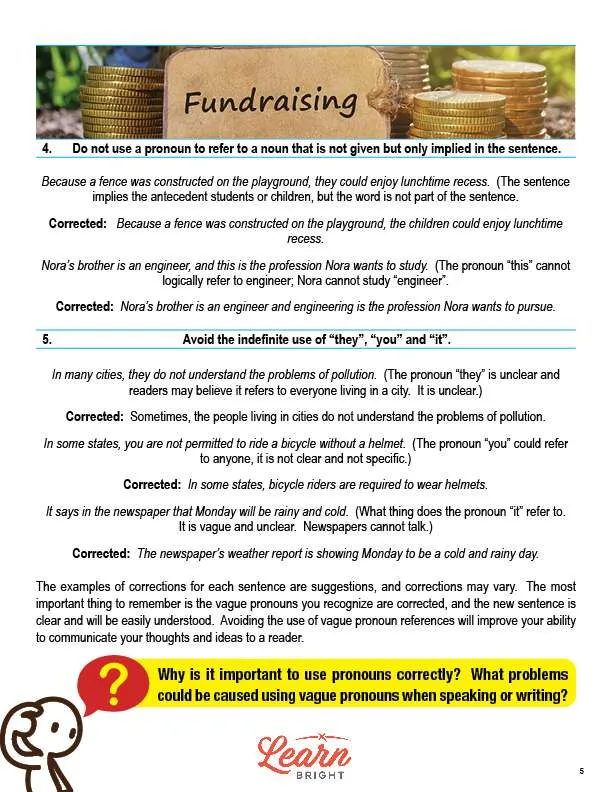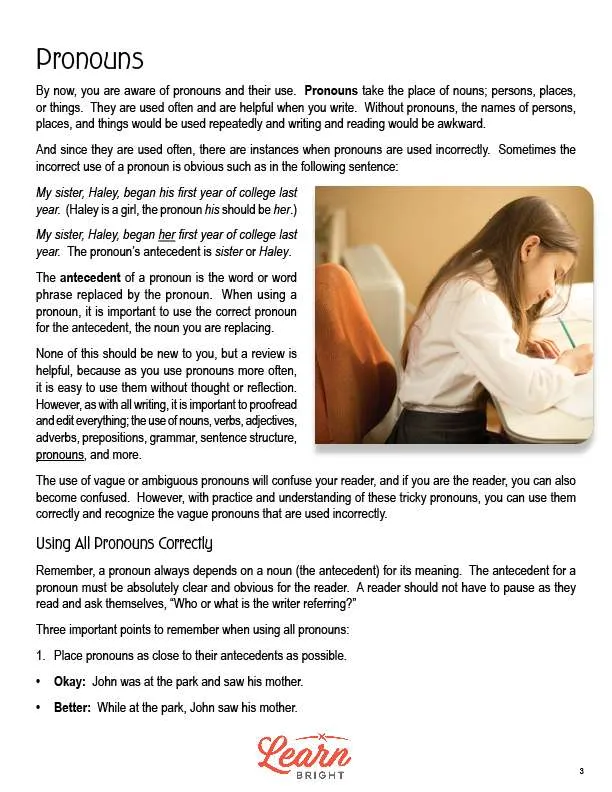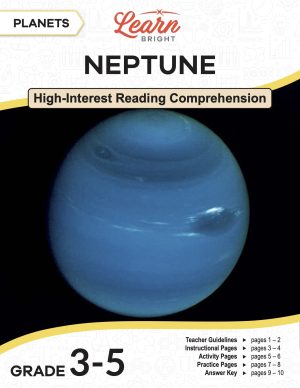Description
What our Correcting Vague Pronouns lesson plan includes
Lesson Objectives and Overview: Correcting Vague Pronouns clarifies the proper use of pronouns, especially those with unclear and ambiguous antecedents. Most students can easily identify a pronoun, but sometimes when writing they may use a pronoun incorrectly, causing confusion for a reader. At the end of this lesson, students will be able to recognize and correct vague pronouns, ones with unclear or ambiguous antecedents. This lesson is for students in 5th grade and 6th grade.
Classroom Procedure
Every lesson plan provides you with a classroom procedure page that outlines a step-by-step guide to follow. You do not have to follow the guide exactly. The guide helps you organize the lesson and details when to hand out worksheets. It also lists information in the green box that you might find useful. You will find the lesson objectives, state standards, and number of class sessions the lesson should take to complete in this area. In addition, it describes the supplies you will need as well as what and how you need to prepare beforehand. The only supplies you will need for this lesson are the handouts. To prepare for this lesson ahead of time, you can copy the handouts.
Options for Lesson
Included with this lesson is an “Options for Lesson” section that lists a number of suggestions for activities to add to the lesson or substitutions for the ones already in the lesson. One optional addition to this lesson is to have students read some incorrect sentences out loud while the other students correct it. You can also hold a “Vague Pronoun Bee” for the students, where you present sentences to each team and have them correct them. Finally, students can use their current reading content, change correct sentences to be vague or incorrect, and then have other students correct them.
Teacher Notes
The teacher notes page includes a paragraph with additional guidelines and things to think about as you begin to plan your lesson. This page also includes lines that you can use to add your own notes as you’re preparing for this lesson.
CORRECTING VAGUE PRONOUNS LESSON PLAN CONTENT PAGES
Pronouns
The Correcting Vague Pronouns lesson plan includes three pages of content. The lesson begins by reminding students that pronouns take the place of nouns (people, places, things). We use them when we write, because our writing would be awkward without them. Even though we use them often while writing, we can use them incorrectly! Sometimes it’s easy to see when a pronoun is used incorrectly, because it sounds obviously wrong when we read it. (The lesson includes a few examples of this.) An antecedent is a word or word phrase that the pronoun replaces. We must use the correct pronoun for the antecedent.
The more we use pronouns, the less we might think about how we are supposed to be using them. This is why it’s so important to always proofread and edit your writing! If you use vague or ambiguous pronouns, you risk confusing your reader. On the other hand, if you’re reading something and come across an incorrect pronoun, you can become confused. However, if you pay attention and practice using pronouns correctly, you can avoid using vague or incorrect pronouns.
Using All Pronouns Correctly
Pronouns always depend on the noun (antecedent) for their meaning. This is why it’s so important to make sure that the antecedent is clear and obvious to the reader. You don’t want your readers to have to stop reading to figure out who or what your pronouns are referring to!
There are three important things to remember for using pronouns. The lesson outlines these three things and includes some helpful examples of what to do (and what not to do!).
First, you should place pronouns as close to their antecedent as possible to make the connection obvious. Second, you should make pronoun references exact. Finally, when possible, you should mention the noun before you replace it with a pronoun.
Recognizing and Correcting Vague Pronouns
We define vague pronouns as any pronoun that is unclear to a reader. There are three basic rules for avoiding vague pronouns. The lesson lists these rules and includes examples and corrections for reference.
The first rule is to avoid having more than one possible antecedent for a pronoun. The second rule is to avoid references to antecedents which are remote from the pronoun (and avoid a placement that confuses the reader). The third rule is to avoid using words like this, that, or which to refer to general ideas in preceding clauses or sentences. Pronouns should typically refer to a single word in the previous sentence.
CORRECTING VAGUE PRONOUNS LESSON PLAN WORKSHEETS
The Correcting Vague Pronouns lesson plan includes three worksheets: an activity worksheet, a practice worksheet, and a homework assignment. You can refer to the guide on the classroom procedure page to determine when to hand out each worksheet.
INCORRECT SENTENCES ACTIVITY WORKSHEET
Students will work with a partner to complete the activity worksheet. They will work together to write ten incorrect sentences that use vague pronouns. On a separate sheet of paper, they’ll create an answer key. They will create at least one sentence for each of the five rules. Once they’re finished, they will exchange their sentences with another pair of students. They will correct the other pair’s sentences and will meet with them to discuss the corrections.
Students can work either alone or in groups for this activity if you’d prefer.
IDENTIFY VAGUE PRONOUNS PRACTICE WORKSHEET
For the practice worksheet, students will complete three exercises. The first asks them to read pairs of sentences and put an X next to the sentence with a vague pronoun reference. They will then write down why the sentence is incorrect. The second exercise asks them to correct five incorrectly written sentences. The third exercise asks you to fill in the blanks in sentences related to pronoun rules.
CORRECTING VAGUE PRONOUNS HOMEWORK ASSIGNMENT
The homework assignment asks students to first match incorrectly written sentences with the rule it did not follow. Next, they will correctly rewrite each of the sentences.
Worksheet Answer Keys
This lesson plan includes answer keys for the practice worksheet and the homework assignment. If you choose to administer the lesson pages to your students via PDF, you will need to save a new file that omits these pages. Otherwise, you can simply print out the applicable pages and keep these as reference for yourself when grading assignments.









